Considerations for Wearing Masks
To Help Slow the Spread of COVID-19
What you need to know
- People age 2 and older should wear masks in public settings and when around people who don’t live in their household.
- Masks offer some protection to you and are also meant to protect those around you, in case you are unknowingly infected with the virus that causes COVID-19.
- A mask is NOT a substitute for social distancing. Masks should still be worn in addition to staying at least 6 feet apart.
- Wash your hands with soap and water for at least 20 seconds or use hand sanitizer with at least 60% alcohol after touching or removing your mask.
- Masks may not be necessary when you are outside by yourself away from others, or with other people who live in your household. However, some localities may have mask mandates while out in public and these mandates should always be followed.
- CDC is still studying the effectiveness of different types of masks and will update our recommendations as new scientific evidence becomes available.
Evidence for Effectiveness of Masks
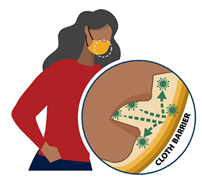
Your mask helps protect those around you
COVID-19 spreads mainly from person to person through respiratory droplets. Respiratory droplets travel into the air when you cough, sneeze, talk, shout, or sing. These droplets can then land in the mouths or noses of people who are near you or they may breathe these droplets in.
Masks are a simple barrier to help prevent your respiratory droplets from reaching others. Studies show that masks reduce the spray of droplets when worn over the nose and mouth.
You should wear a mask, even if you do not feel sick. This is because several studies have found that people with COVID-19 who never develop symptoms (asymptomatic) and those who are not yet showing symptoms (pre-symptomatic) can still spread the virus to other people. The main function of wearing a mask is to protect those around you, in case you are infected but not showing symptoms.
It is especially important to wear a mask when you are unable to stay at least 6 feet apart from others since COVID-19 spreads mainly among people who are in close contact with one another (within about 6 feet).
Your mask offers some protection to you
A cloth mask also offers some protection to you too. How well it protects you from breathing in the virus likely depends on the fabrics used and how your mask is made (e.g. the type of fabric, the number of layers of fabric, how well the mask fits). CDC is currently studying these factors.
Who Should or Should Not Wear a Mask
Who should wear a mask
Everyone 2 years of age and older should wear a mask in public settings and when they are around people who do not live in their household.
Wear a mask when caring for someone who is sick with COVID-19 (whether at home or in a non-healthcare setting). If you are sick with COVID-19 or think you may have COVID-19, wear a mask when you need to be around other people or animals, even in your own home.
CDC recognizes there are specific instances when wearing a mask may not be feasible. In these instances, consider adaptations and alternatives.
Who should not wear a mask
Masks should not be worn by
- Children younger than 2 years old
- Anyone who has trouble breathing
- Anyone who is unconscious, incapacitated or otherwise unable to remove the mask without assistance
- Wearing masks may be difficult for some people with sensory, cognitive, or behavioral issues. If they are unable to wear a mask properly or cannot tolerate a mask, they should not wear one, and adaptations and alternatives should be considered
Types of masks
Some masks work better to help stop the spread of COVID-19 outside of healthcare settings. Medical masks and N-95 respirators should not be used because they should be conserved for healthcare workers.
Recommended
Not Recommended
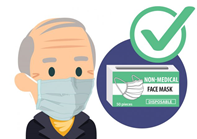
Non-medical disposable masks
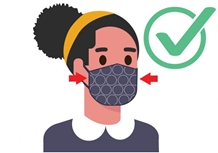
Masks that fit properly (snugly around the nose and chin with no large gaps around the sides of the face)
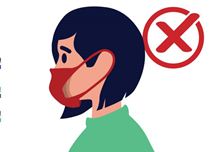
Masks that do not fit properly (large gaps, too loose or too tight)
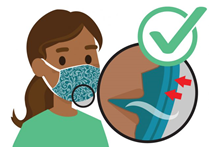
Masks made with breathable fabric (such as cotton)
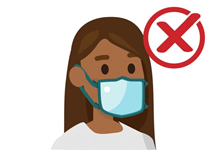
Masks made from materials that are hard to breathe through (such as plastic or leather)
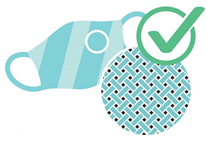
Masks made with tightly woven fabric (i.e., fabrics that do not let light pass through when held up to a light source)
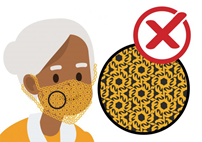
Masks made from loosely woven fabric or that are knitted, i.e., fabrics that let light pass through
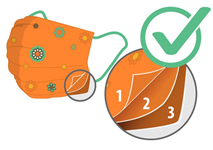
Masks with two or three layers
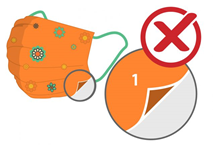
Masks with one layer
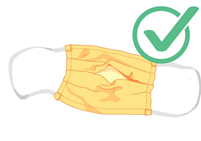
Masks with inner filter pockets
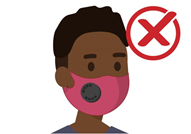
Masks with exhalation valves or vents
Cloth masks
The most effective fabrics for cloth masks are
- Tightly woven fabrics, such as cotton and cotton blends
- Breathable
- Two or three layers
Less effective fabrics for cloth masks are
- Loosely woven fabrics, such as loose knit fabrics
- Difficult to breathe through (like plastic or leather)
- Single layer
CDC is currently studying the effectiveness of various cloth mask materials. We will update this guidance as we learn more.
Non-medical disposable masks
Disposable face masks are single-use masks. They are sold online and through large retail stores. These are not the same as surgical or other medical masks.
You may prefer using disposable masks in situations where your mask is likely to get wet or dirty. As with cloth masks, make sure your disposable mask fits close to your face without large side-gaps and completely covers your nose and mouth. Bring extra disposable masks with you in case you need to change out a dirty or wet mask.
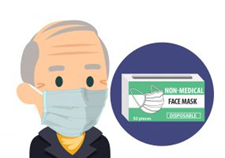
Masks with exhalation valves or vents
CDC does not recommend using masks with exhalation valves or vents because this type of mask may not prevent you from spreading COVID-19 to others. The hole in the material may allow your respiratory droplets to escape and reach others. Research on the effectiveness of these types of masks is ongoing.
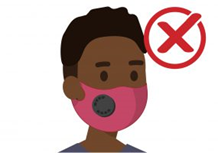
Surgical masks and respirators
Do not use surgical masks and respirators that are meant for healthcare workers. Currently, surgical masks and respirators are critical supplies that should be reserved for healthcare workers and other medical first responders to prevent supply shortages.
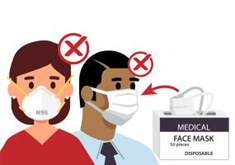
Clear masks or cloth masks with a clear plastic panel
Clear masks or cloth masks with a clear plastic panel are an alternative type of mask for people who interact with
- People who are deaf or hard of hearing
- Young children or students learning to read
- Students learning a new language
- People with disabilities
- People who need to see the proper shape of the mouth for making appropriate vowel sounds, e.g., in singing
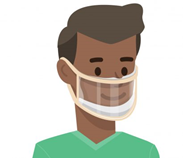
If you use this type of mask, make sure
- You can breathe easily
- Excess moisture does not collect on the inside of the mask
- You remove the mask before sleeping, since the plastic part could form a seal around your mouth and nose and make it hard to breathe
The FDA recently cleared a transparent pdf iconexternal iconmedical mask. These transparent medical masks should be reserved for use by healthcare workers and patients who require them.
Other Types of Face Protection
CDC does not recommend using face shields or goggles as a substitute for masks. Do NOT put a plastic face shield (or a mask) on newborns or infants.
Face shields and goggles are primarily used to protect the eyes of the person wearing it. Goggles do not cover the nose and mouth. Face shields have large gaps below and alongside the face, where your respiratory droplets may escape and reach others around you. At this time, we do not know how much protection a face shield provides to people around you. However, wearing a mask may not be feasible in every situation for some people.
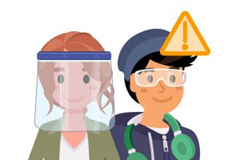
Face shields and goggles
For example, people who interact with those who are deaf or hearing impaired may find that a face shield is better than a mask when communicating. If you must wear a face shield instead of a mask:
- Choose a face shield that wraps around the sides of your face and extends below your chin or a hooded face shield. This is based on the limited available data that suggest these types of face shields are better at preventing spray of respiratory droplets.
- Wash your hands before and after removing the face shield. Avoid touching your eyes, nose, and mouth when removing it.
- Clean and disinfect reusable face shields according to the manufacturer’s instructions or by following CDC face shield cleaning instructions. If you use a disposable face shield, wear it once and throw it away according to the manufacturer’s instructions.
Mask Adaptations and Alternatives
CDC recognizes that wearing masks may not be possible in every situation or for some people. Those who cannot wear a mask are urged to prioritize virtual engagement when possible. For in-person activities, we have provided a few examples of what you can do to make wearing a mask more feasible and how to reduce the spread of COVID-19 if you cannot wear a mask.
Situations where wearing a mask may not be possible
- Make sure to maintain physical distance from others when you cannot wear a mask.
Dining
- CDC recommends wearing a mask while dining in a restaurant except when actively eating or drinking.
Water activities
- Do not wear a mask when doing activities that may get your mask wet, like swimming at the beach or pool. A wet mask can make it difficult to breathe and may not work as well when wet.
High intensity activities
- Masks should be used in public settings, but if you are unable to wear a mask because of difficulty breathing during high intensity activities, choose a location with greater ventilation and air exchange (for instance, outdoors versus indoors) and where you can keep at least 6 feet from others during the activity.
- If you are able to wear a mask, remove your mask if it gets moist from sweat and replace it with a clean mask.
- Opt for an activity that does not require using mouth guards or helmets. Wearing a mask with these types of protective equipment is not safe if it makes it hard to breathe.
- Supervise children who are wearing a mask while playing sports.
Certain groups of people who may find it difficult to wear a mask
Some children 2 years and older, and people of any age with certain disabilities
Appropriate and consistent use of masks may be challenging for some children and for people of any age with certain disabilities, including cognitive, intellectual, developmental, sensory, and behavioral disorders.
When deciding if children and people with certain disabilities should wear a mask, determine if they can:
- Use a mask correctly
- Avoid frequent touching of the mask and their face
- Limit sucking, drooling, or having excess saliva on the mask
- Remove the mask without assistance
If children and people with certain disabilities are unable to wear a mask properly or cannot tolerate a mask, they should not wear one.
Those caring for children and people with certain disabilities who may not be able to wear a mask should
- Ask their healthcare provider for advice about their wearing a mask
- Ensure proper mask size and fit
- Remove their mask before sleeping, napping, when they may fall asleep (such as in a car seat or stroller), and in situations when continual supervision is not possible
- Consider prioritizing wearing a mask when it is difficult to keep at least 6 feet from others (for example, during carpool drop off or pick up, or when standing in line at schools or stores)
Masks should not be worn by:
- Children younger than 2 years old
- Anyone who has trouble breathing
- Anyone who is unconscious, incapacitated, or otherwise unable to remove the mask without assistance
People who are deaf or hard of hearing, and those who will interact with people who are hearing impaired
If you interact with people who rely on reading lips, you may have difficulty communicating while wearing a mask.
- Consider wearing a clear mask or a cloth mask with a clear panel
- If you are not able to get a clear mask, consider using written communication, closed captioning, or decreasing background noise to make communication possible while wearing a mask that blocks lips
People with certain underlying medical conditions
Most people with underlying medical conditions can and should wear masks.
- If you have respiratory conditions and are concerned about wearing a mask safely, discuss with your healthcare provider the benefits and potential risks of wearing a mask.
- If you have asthma, you can wear a mask. Discuss with your healthcare provider if you have any concerns about wearing a mask.
Outdoor workers
If you work in a setting where masks could increase the risk of heat-related illness or cause safety concerns (for example, straps getting caught in machinery):
- Discuss with an occupational safety and health professional about what mask would be suitable.
- Prioritize wearing masks when in close contact with other people, like during group travel or shift meetings, and remove masks when social distancing is maintained. Some localities may require wearing masks in public outdoors, and these requirements should be followed.
Mask use and carbon dioxide
Wearing a mask does not raise the carbon dioxide (CO2) level in the air you breathe
A cloth mask does not provide an airtight fit across the face. The CO2 completely escapes into the air through and around the sides of the cloth mask when you breathe out or talk. CO2 is small enough to easily pass through any cloth mask material. In contrast, the virus that causes COVID-19 is much larger than CO2, so it cannot pass as easily through a properly designed and properly worn cloth mask.


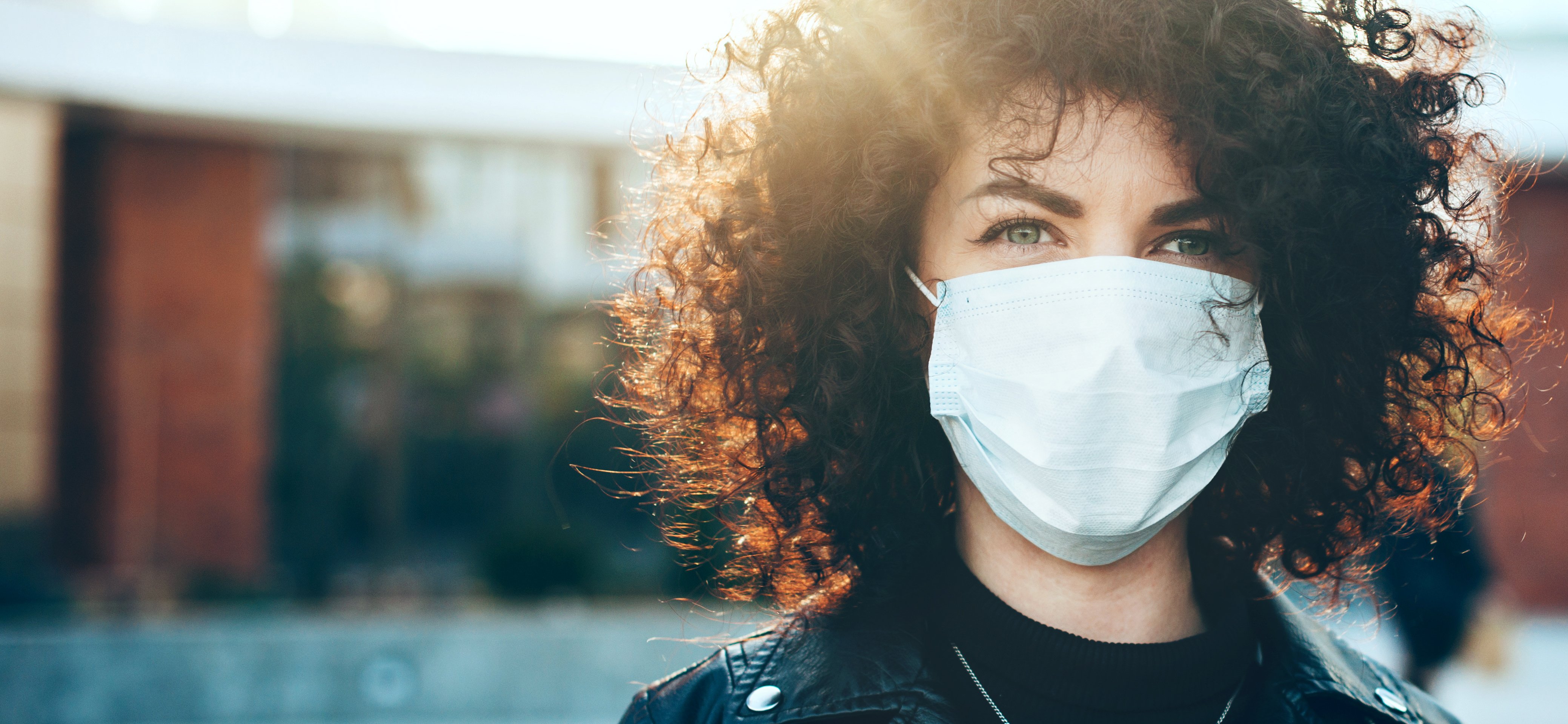

.png?width=110&height=110&name=lane%20badge%20(1).png)
